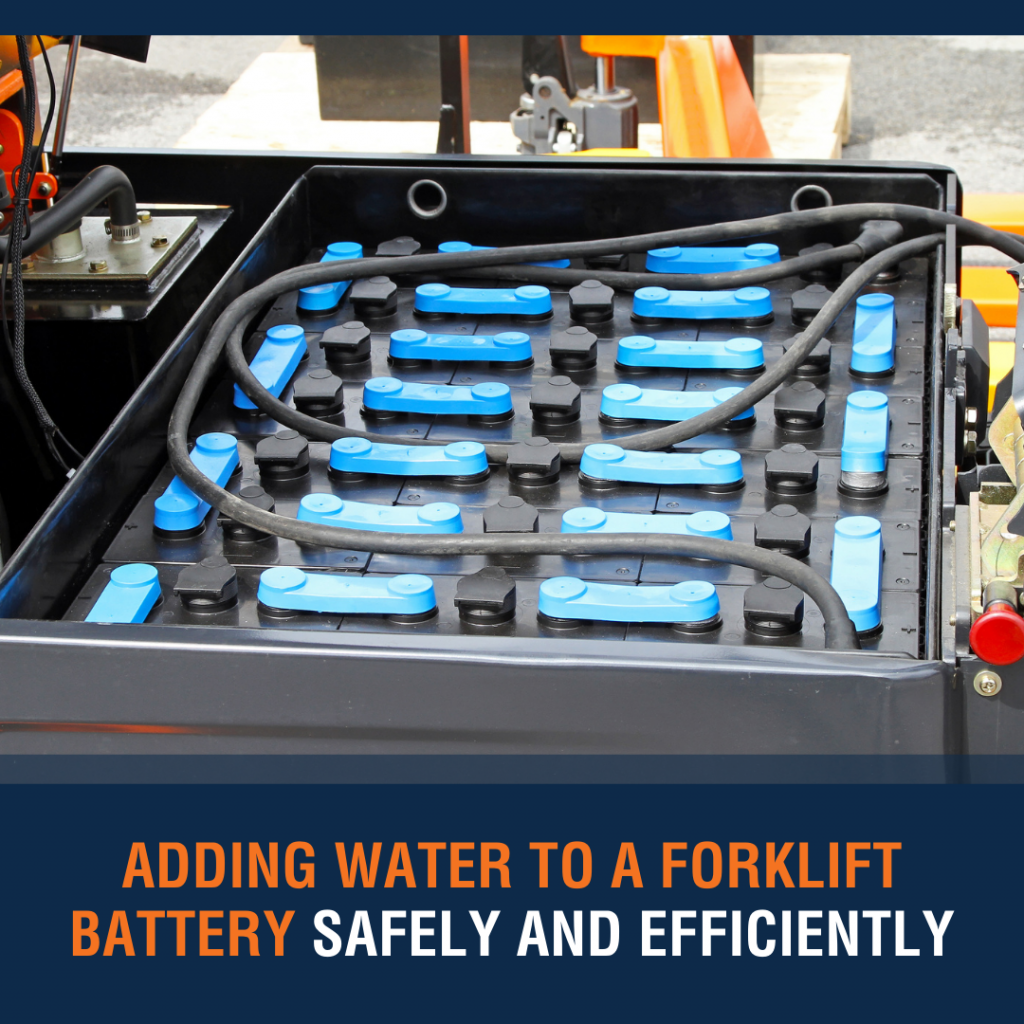We use cookies to make your experience better. To comply with the new e-Privacy directive, we need to ask for your consent to set the cookies. Learn more.
Adding Water to a Forklift Battery Safely and Efficiently
Forklift battery cells require regular watering to keep the electrolyte’s acid-to-water ratio properly balanced. Without regular watering, battery cells dry out, causing permanent damage. Dry cells cost batteries a significant portion of their capacity — and eventually ruin them altogether. Overwatering batteries is just as bad. This practice leads to boil-over during charges, which has been associated with a capacity loss of 3 to 5 percent with every incident.

The good news? By following a few basic tips — and with the right equipment — battery watering can be a simple part of your forklift maintenance schedule. Here’s a quick overview about how to water a forklift battery safely. For a more detailed look at watering forklift batteries in fast-charge applications, see our coverage here.
When to Water a Forklift Battery
The correct time to add water to a forklift battery is right before the shift starts. Always water after the charge cycle — not before or during. Adding water to a charging battery is dangerous, as it significantly increases the chance of a boil-over. Remember: never water lift truck batteries before or during a charge.
Other basic tips to keep in mind:
- Most lift truck batteries require watering every 5-10 charges. This is a general rule, but review the documentation that came with your lift truck and battery.
- Some batteries require water more or less frequently, so you’ll also want to check the battery’s water levels regularly.
- Older batteries often need to be watered more often than newer batteries.
- If forklifts aren’t used frequently, be sure to check their water levels at least once per week.
- Don’t add water mid-shift. This increases the risk of a boil-over.
Keeping these principles in mind will allow your operators to maintain batteries properly. However, to safely add water, they’ll need access to an appropriate water supply and safe watering equipment.
How to Safely Water Industrial Batteries
When adding water to lift truck batteries, always use deionized or distilled water. The BHS Water Deionizing System is an affordable way to ensure a steady supply of deionized water appropriate for use in lead-acid batteries.
Workers should wear appropriate safety equipment (splash goggles, face shields, aprons, and gloves) when filling batteries with water. This applies to all watering equipment, including portable systems. Lead-acid batteries contain sulfuric acid, which can pose a serious hazard. Battery rooms should also have facilities for drenching the eyes and body.
Finally, watering equipment should be ergonomic and intuitive. Workers should have access to high-quality equipment, which improves speed while limiting the chances of overwatering and boil-overs. One essential item? The BHS WG-X Watering Gun, equipped with an automatic shutoff feature and an ergonomic handle.
The WG-X has a compact, lightweight design specifically optimized for watering forklift batteries. Since it can connect to Water Carts & Tanks, the BHS Water Deionizing System, or even a standard hose, it’s ideal for quick implementation in any operation. The gun allows for efficient, accurate filling while keeping workers safe. The WG-X Watering Gun’s automatic shutoff feature is particularly beneficial here; the feature adds an extra safeguard to prevent overwatered cells, and the easy-grip handle limits the chances of musculoskeletal injuries for workers who refill batteries regularly during their shifts.
Explore BHS Battery Watering Devices and Systems — including the WG-X Watering Gun — here.
Learn More About Safe Battery Watering Practices for Forklifts
Knowing when to add water to forklift batteries is important, particularly for battery room workers. Managers should take appropriate steps to train employees — and to explain the importance of regular watering.
For more information, read our Watering Forklift Batteries: The Complete Guide for Battery Room Operators. This detailed resource includes a checklist for improving your facility’s forklift maintenance practices, along with tips for setting up training programs and ensuring that workers understand the why, how, and how often of forklift battery watering.
The guide also contains equipment recommendations for facilities of various sizes. With some quick planning, your operation can get more from its lift truck fleet — while keeping its budget in check.
